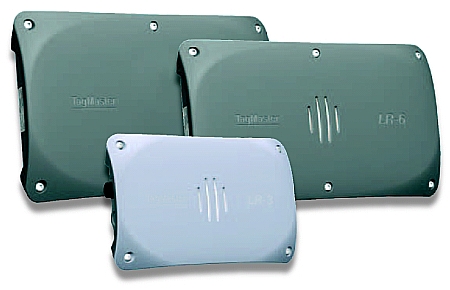Linux adds flexibility to “long-range” RFID readers
Aug 29, 2006 — by LinuxDevices Staff — from the LinuxDevices Archive — 5 views RFID specialist TagMaster used embedded Linux to build a new generation of “long-range and high-performance” 2.45 GHz RFID systems. The LR-xx readers operate in the license-free 2.45 GHz frequency band, and target applications in commercial and corporate parking areas, gated communities, university parking, airports, and… hospitals, according to the company.
RFID specialist TagMaster used embedded Linux to build a new generation of “long-range and high-performance” 2.45 GHz RFID systems. The LR-xx readers operate in the license-free 2.45 GHz frequency band, and target applications in commercial and corporate parking areas, gated communities, university parking, airports, and… hospitals, according to the company.
The new generation currently spans three models, the LR-12, LR-6, and LR-3 readers (pictured below). Each model number indicates the range, in meters, of the reader (i.e. the LR-6 has a six meter range).

The readers are protected from environmental hazards to IP65 (Ingress Protection 65) levels, allowing them to mounted outdoors without any additional protection from the elements, according to the company.
Key new features in the LR-xx readers, the company says, include digital signal processing, which enables the devices to support future RFID protocols by means of software updates; adaptive frequency hopping with interference detection; and improved connectivity by means of Ethernet and USB.
Another important benefit of the LR-xx series, according to TagMaster, is that the devices' control software is based on a standard open-source Linux operating system (currently based on a 2.6.16 Linux kernel), allowing the devices to be “easily programmable.”
To maximize the usefulness of the embedded Linux software platform, the company supports the devices with an “open development platform” and supplies a free SDK (software development kit) that runs on both Linux and Windows hosts. The SDK enables integrators to “quickly develop and implement new applications for the LR-6 reader,” the company says.
The readers can be configured and controlled via the Ethernet interface, either locally or remotely via an Internet connection, according to TagMaster.
Typical features and specs of the LR-xx series, as listed by the company, include:
- Read range up to 12 meters (depending on model)
- Accurate real-time clock (RTC)
- Ethernet, RS232, RS485, and Wiegand/Mag-stripe interfaces
- General purpose input and output I/O ports
- User-selectable radio channels ensuring smooth operation in multiple reader installations
- Weather proof IP65 enclosure
- Extremely low RF power output, CE and FCC approved — no site license required
- Operating temperature — -4 to +140 degrees F (-20 to +60 degrees C)
- Flexible supply voltage (10 to 30 VDC)
- Memory — 16MB flash; 32MB RAM
- Standard Linux operating system
- User-programmable with TagMaster SDK including TCP/IP communication and SQL database support
TagMaster president Magnus Rehn stated, “We have collaborated with an industrial designer to develop a clean and modern design for the readers. We have also focused on creating new features for better functionality. The new readers have the lowest output power in the market as well as the longest read-range. They can also be connected to cameras, external memories, or modems with a USB cable. The new design also makes it easier for service technicians to reach the electronics.”
Availability
The company, which is based in Sweden, opened an office in the U.S. in June. The LR-3 and LR-6 are expected to ship in the U.S. starting in September, with the LR-12 available by year end. Pricing was not disclosed.
This article was originally published on LinuxDevices.com and has been donated to the open source community by QuinStreet Inc. Please visit LinuxToday.com for up-to-date news and articles about Linux and open source.